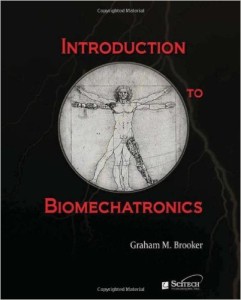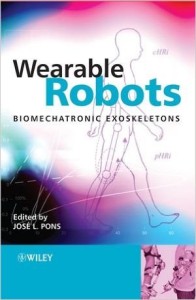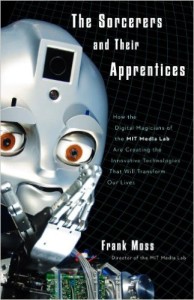There are several books on the topic of exoskeletons and wearable robotics that are worth owning, and some that should most likely be skipped. Below are seven tittles for your consideration and a few suggestions on where you can find them:
Wearable Robots, Biomechatronic Exoskeletons by José L. Pons, 2008
This is possibly the best exoskeleton book available on the market in 2015! The book is divided into two main sections: in the first section, the author provides a thorough analysis of principles and challenges for making exoskeletons and ties each concept with an overview of one or two research projects. The selections are from all over the world and focus on the issues discussed in that chapter. The second section of the book places a much greater emphasis on explaining the work of different exoskeleton labs grouped by research focus.
Overall, Wearable Robots never tries to fully exhaust a subject but presents to the user the “biomechatronics approach,” the human body, its range of mechanical capabilities and electrical control by the brain (biology, mechanics and electronics). The biomechatronics approach is then applied to explain the limitations of robotic technology (mechanical and electronical) for building exoskeletons and the necessary bio-compatibility. Since the book puts an emphasis on concepts and ideas, the publishing date and its age is not an issue and it should be in the library of all power exoskeleton enthusiasts! You can find Wearable Robots, Biomechatronic Exoskeletons on Amazon.com
Exoskeletons in Rehabilitation Robotics: Tremor Suppression by José L. Pons, 2008
…is exactly the opposite of the preceding entry. Where Wearable Robots explored different exoskeleton research projects, Tremor Suppression focuses entirely on one application. Tremor suppression was a very popular topic in the 2000s but has mostly fizzled since with the noticeable exception of the Rehab Robot HARMONY – ReNeu Robotics Lab, UT Austin. The main shortcoming of this book is that it explores very few mechanical prototypes and the language is dry and highly technical. Exoskeletons in Rehabilitation Robotics, Tremor Suppression is definitely not for the casual exoskeleton enthusiast but you can still pick it up on Azamon.com.
The Sorcerers and Their Apprentices, How the Digital Magicians of the MIT Media Lab Are Creating the Innovative Technologies That Will Transform Our Lives by Frank Moss, 2011
Written by Frank Moss, the director of the MIT Media Lab from 2006 to 2011, this book contains only two pages dedicated to exoskeletons. This however, shouldn’t disqualify the book from making it on your reading list. What the apprentice lacks in wearable robotic specific material it more than makes up in its wonderful insights into multi-disciplinary research. In the MIT Media Lab, prototypes are designed by a mix of engineers, research scientists, artists and people that are seeking to fulfill a need. The author heavily emphasizes how many inventions started out as rehabilitation technology (just like exoskeletons) only to balloon out into everyday life. This book is a really fun and quick read and can be picked up for cheap at Amazon.com.
Strength Training Anatomy by Frederic Delavier, 2005
Every time I talk to rehabilitation professionals the conversation veers into specific muscle groups within the first minute. Strength Training Anatomy is an atlas that gives you the location, name and function of all major skeletal muscle groups in the body. This knowledge is also essential when looking at mathematical 3D models that attempt to approximate the impact of exoskeletons on the human body, (see example AnyBody Simulation). In addition, almost all passive exoskeletons rely on anatomical knowledge and target/augment only 1-2 specific joints or muscles. Finally, multiple soft exoskeleton designs are experimenting with applying forces along the length and in parallel to skeletal muscles, rather than just torque at a joint. Having a handy picture guide in the form of this or similar books can be quite useful for any exoskeleton technology enthusiast. You can pick up this book or its new 3rd edition (2010) at Amazon.com.

This book is meant to act as a textbook that positions students to enter the wearables market. Unfortunately, the first half of the book ends up reading like a loosely agglomerated Wikipedia articles. The second part analyzes bio compatible devices that augment or replace human functions: iron lungs, artificial vision… In my opinion, this text has little value for the average exoskeleton buff, but if you want t0 you can see more details at Amazon.com.
Biomechatronics in Medicine and Health Care by Raymond Tong, 2011
This book is filled with rehabilitation exoskeleton devices. There are some lower extremities exoskeletons but the main focus is clearly in full arm and below the wrist only rehabilitation wearable robots. However, time has not been a friend to this volume. While the text was printed in 2011, you will be hard pressed to find much material before 2007. Without a technological overview section or many forward looking statements this text begins to resemble a graveyard of obscure and forgotten research projects that were terminated once the funding ran out. If you haven’t been discouraged, you can find this book and more information on it at Amazon.com.
Biomechatronic Design in Biotechnology, A Methodology for Development of Biotechnological Products by Carl-Fredrik Mandenius, 2011
Saving the worst for last, there is only one thing you need to know about this book, SKIP! Up until a few years ago, biomechatronics was becoming a more and more popular term describing the intersection between mechanical and electrical engineering as applied to or inspired by biology. Exoskeleton technology used to fit squarely within biomechatronics and this website’s predecessor was even named after the term (Biomechatronics.net, no longer operational). Recently, however, the term has fallen out of favor and I am sure that books like this contributed to it. The text is about Biotechnology solutions that companies have come up with over the years, but there is no biomechatronics to be found anywhere. The author creates strenuous justifications throughout the text to explain the title. For example, arguing that liquid chromatography is biomechatronics because there is a pump (mechanism), conductivity and pressure sensors (electronics) and the separation medium is organic. You can find more detail on this title here: Amazon.com but if I could, I would go back in time and stop myself from purchasing it. Anyone have a DeLorean?
Some of these books can be quite expensive, but before you buy, don’t forget to check in your local libraries! Also, you can ask your local librarian to help you find articles. WorldCat.org is another great resource website that is connected to over 10,000 library catalogs.














What is the updated list for 2019? I would like to know if you have a new list coming up!
Hi Parker, making a 2019 list has been on our to-do list for a long time. Stay tuned!
Hey, when can we expect the new list. I know it’s a lot of work, but would really appreciate it.
Fair question! I haven’t thought much about it, though just recently I got two new books on exoskeleton technology that I am still reading through.
Hey, mind sharing the names?